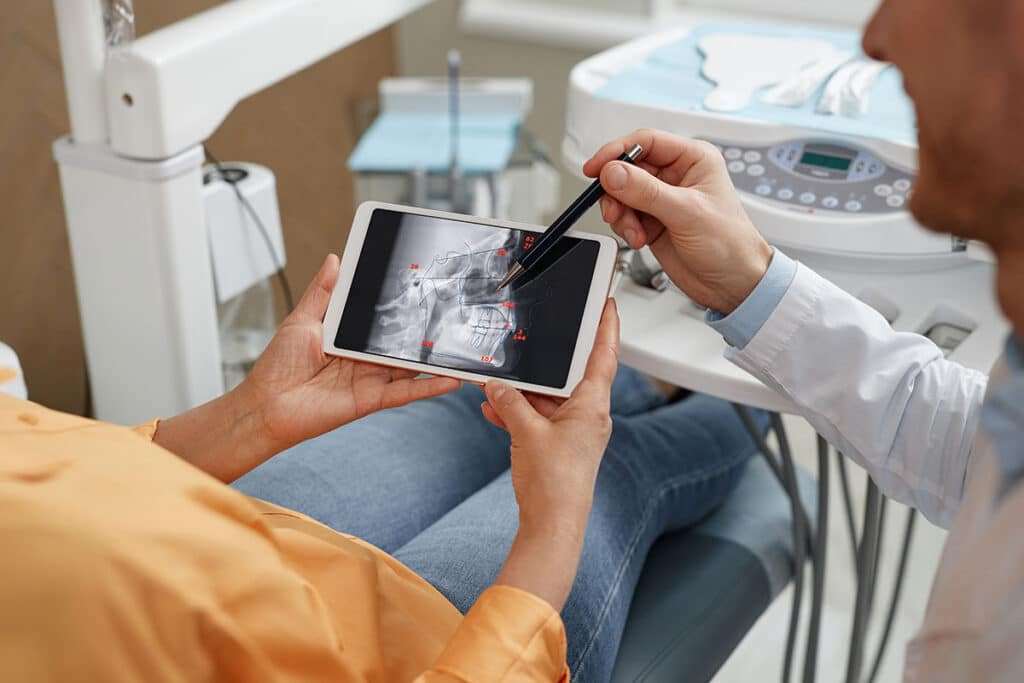Dental Digital Imaging

What does digital imaging encompass?
Dental imaging encompasses a range of advanced methods and technologies utilized in dentistry to capture highly detailed images of teeth, jawbone, and adjacent oral structures. These images are essential tools for diagnosis, treatment planning, and ongoing monitoring in dental care. They offer crucial insights into a patient’s oral health, empowering dentists to render precise diagnoses and craft effective treatment strategies.
Dental imaging includes various techniques, such as intraoral X-rays, extraoral X-rays, digital radiography, 3D imaging, intraoral cameras, digital impressions and the digital storage of the data created.
What is digital imaging used for?
Dental digital imaging is an extremely important aid when diagnosing and treating dental health. When the dentists in our office need to take a closer look, they will determine which type of digital imaging is most suitable.
X-rays and other digital imaging techniques enable dentists to detect cavities in places in between your teeth and determine the shape and health of your jawbone. Other things can be observed too, such as the roots and nerves of your teeth. They can also diagnose lesions such as cysts or tumours in extreme cases and help assess initial damage when trauma occurs.
Modern dentistry has long since advanced past the thick file folders with treatment notes and photographs to digitally store patient information. This makes it easy to recall and share patient information, like an X-ray between a dentist and an orthodontist. It’s also beneficial when dentists need to explain or consult with patients because they can easily use visual aids to help.
Digital imaging also greatly speeds up the process, allowing dentists to see results immediately with almost unlimited editing options – zoom, markup, sharing etc.
What are the advantages of modern digital imaging?
There are many advantages of digital imaging including:
- Digital storage of patient images that allows for remote recall and quick transfer between specialists or insurance companies if necessary.
- Digital X-rays are viewed on a computer monitor instead of holding a 35mm film up to the light.
- They offer more precision as a result of this while exposing you to 1/6 less radiation.
Should patients be concerned about digital imaging-related procedures?
The biggest culprit for making patients wary is the dental X-ray or the rarely used CT scan. X-rays and radiographic imaging are important and can often not be substituted adequately, but luckily, radiation levels and exposure time when using dental radiographs are very minimal. This is important for everyone, but even more so for mothers visiting the dentist while pregnant.
Another added advantage of digital imaging is that it allows us to store patient images and quickly transfer these images to appropriate specialists or insurance companies if necessary.
Digital X-rays are viewed on a computer monitor instead of holding a 35mm film up to the light. They offer more precision as a result of this while exposing you to 1/6 less radiation.
Please read our page about digital imaging and dental X-rays for more information.
Martindale Dental provides both general and specialty dentistry under one roof. For more than 20 years, our dentists have been advocates for their patient’s oral health care needs.
Our dental offices are conveniently located throughout the GTA in Hamilton (Jackson Square), and St. Catharines, Ontario. We offer convenient appointments before or after work & on weekends.
Martindale Dental provides both general and specialty dentistry under one roof. For more than 20 years, our dentists have been advocates for their patient’s oral health care needs.
Our dental offices are conveniently located throughout the GTA in Hamilton (Jackson Square), and St. Catharines, Ontario. We offer convenient appointments before or after work & on weekends.
